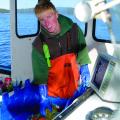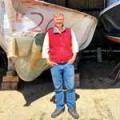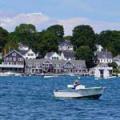Awanadjo Almanack - Issue 111
from seed to sprout to bud to flower and to seed again.
By Rob McCall
 Illustration by Sam Manning.
Illustration by Sam Manning.
Summer ends and autumn comes, and he who would have it otherwise would have high tide always and a full moon every night.
Dear Friends: Downeast Maine’s trademark fruit, the wild blueberry, is the great-grandmother of all lesser, cultivated varieties. I say lesser because, for all their bulk, no cultivated blueberry can match the superb flavor of the wild variety. I say great-grandmother because fruits are decidedly female. They are the ovaries that remain when the male parts of the flower have performed their duties, then dried up and fallen off. Blueberry culture may be the oldest form of agriculture in our region. We are told that slash-and-burn cultivation began during the middle archaic period in Maine, starting around 3,000 B.C. The first Maine natives noticed that blueberries came back more abundantly after a wildfire and began purposely burning the barrens. Burning the blueberry barrens is still a regular event in the spring, as are the occasional forest fires and house fires that accompany this ancient practice. The burning suppresses competitive vegetative growth and helps destroy damaging insects. More recent Maine history shows that blueberries were legally considered to be common property until about 1870. Like deer and other game, they could be taken by anyone, not just the owner of the land on which they grew. The invention of a canning process and action by the legislature changed all that, and led to a commercial blueberry industry and another kind of blueberry “baron.” The late Robert McCloskey’s classic book Blueberries for Sal spread the romance of this tiny fruit throughout the country during the 1950s. More recently, research showing that blueberries are a potent anti-oxidant has increased their popularity among the health-conscious. The harvest is in full swing by late August. The old wooden crates stenciled with the names of Wyman or Allen are now collector’s items, and the new multi-colored plastic flats are stacked in the fields and hauled to the coolers in flat-bed trucks. Meanwhile, rakers bend side-by-side to the harvest. Stores and road-side stands with their handmade signs overflow with bulging boxes of the beautiful fruit. Natural events Your commentator’s experience picking blueberries is mostly on the slopes of Awanadjo, Blue Hill, “small misty mountain” in Algonkian. One foggy morning several years ago our big black dog startled some rakers on those fields. “Did you think he was a bear?” I asked. “Oh yeah,” one of the rakers replied. “A big black bear came down off the mountain to eat berries just a little while ago and then ran back up over the mountain. We scared him, but no more than he scared us.” What could be more glorious than stooping under the wild blue yonder and plucking clumps of this delicious fruit until we can eat no more? Even the droppings of foxes, coons, and bears along the trails are blue. Maybe that is why the flag of the state of Maine is blue, too: Blueberries, blue tongues, blue fingers, blue barrens, blue herons, Blue Hill, blue water, blue yonder, blue planet... and blue hearts when this true-blue season ends.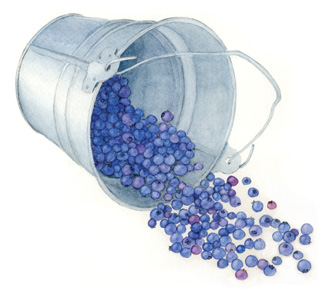 Illustrations by Candice Hutchinson [3].
Illustrations by Candice Hutchinson [3].
Rank Opinion
We owe it all to the growers and the workers who bring us this beautiful, sweet, juicy essence of Maine. There are close to 20,000 migrant laborers—men, women, and children—here in Maine for the blueberry harvest. They deserve our thanks and need our support. Go to the website of the Maine Migrant Health Program (www.mainemigrant.org) or e-mail me (awanadjoalmanack@gmail.com) to see how you can help.
Seedpod to carry around with you
From Woody Guthrie: “Every state in this Union us migrants have been. We come with the dust and we’re gone with the wind.”
Field and forest report, early September
The fields and roadsides are decorated with clouds of white and purple asters, and many kinds of goldenrod sway on their tall stalks in the cooling northern breezes. Queen Anne’s lace is going by, leaving small brown bird’s nests of seeds atop their long stems. Blueberries and partridge berries carpet the ground with their blue and red fruits, while blackberries ripen in their thorny thickets—sweet food for the foragers, both two- and four-legged. Dragonflies fill the evening air and chirping finches feed on seeds a-plenty.
Another seedpod to carry around with you
From Hesiod, the 8th-century B.C. Greek poet: “It will not always be summer: build barns.”
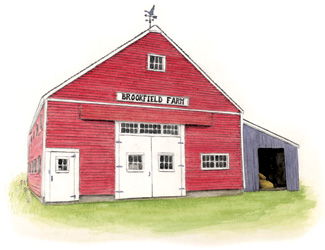 Natural events, mid-September
With just a few days left in calendar summer, we have come full circle from seed to sprout to bud to flower and to seed again over the course of the past season. But these seeds now falling to the ground are ever so slightly different from the parents whose fruit they are. Shaped and shifted by their source, their surroundings, and the mysteries of mutation, the seeds of this late summer are minutely and marvelously adapted to the world as it is now, not the world as it was just a year or two ago.
The new generation of goldfinches or eiders, and the new generation of thistles or mussels on which they feed, may look identical to their ancestors, but their genetics are unique and even more finely fitted to their changing environment.
Likewise, the children who go off to school today live in a world very different from the world into which their grandparents were born, and are far more at home in it. Just ask any grandparent fumbling with a computer or a remote control. And so it goes, season after season, tomorrow tucked into the seeds of today.
Field and forest, mid-September
Swamp maples are beginning to flame up red in the marshes. Acorns are falling from the oaks and into the world of the chipmunks, squirrels, and blue jays that are busily filling up their winter stores and planting the oaks of tomorrow. Apples grow sweet and their seeds get brown and fat till the fruit plops into picking buckets or falls to the ground. If you have a hankering for a Wolf River or a Golden Delicious from the orchard by the parsonage, give us a call or come by. They’re there for the picking, and they’re all organic.
Natural events, early October
At our Cobscook Bay field station last year at this time your commentator was busy doing research on young bones, old rocks, older stars, and the underside of clouds, as well as such culinary experiments as looking for one more way to serve up a can of sardines. With no phone or electricity or human companionship, I could have found that solitude was a sure recipe for loneliness, but it was not. Blue jays and ravens chattered, sea ducks flocked and flapped, chipmunks chirped, asters smiled at the sun, and a huge, furry, yellow caterpillar with black tufts ambled along the deck, happily stopping to taste every fallen leaf its huge black eyes could see.
Believe me, I’ve been far, far lonelier at a high school dance, a ball game, a conference, or a cocktail party. That’s because, as tribal people have known for eons and geneticists are just rediscovering today, all these creatures are my true and real relatives. I was at a family reunion in the woods by the shore.
All the crazy cousins were there—not in a hurry, not anxious, not afraid, not lonely—just content to go about their business without ambition or fear, and happy to let me do the same.
Did we talk to each other? Of course we did. One dark night long before dawn, I was awakened by the shrill, soaring howls of coyotes very close by and the answering chanting hoots of loons out on the bay in antiphonal response.
“I was suddenly sensible of such sweet and beneficent society in Nature,” wrote Henry David Thoreau, “in every sight and sound around my house, and infinite and unaccountable friendliness all at once like an atmosphere sustaining me, as made the fancied advantages of human neighborhood insignificant. Every little pine needle swelled with sympathy and befriended me.”
Rank opinion
Loneliness is one of the great and primal fears of our species, because we are likely the most self-conscious of any creature. The song of the human ego is “Me-me-me-me-me-me-me.” And when all our four-legged and six-legged, finned and feathered and flowered relatives hear that song, they turn and get out of the way as we go stomping through the tulips. Our little ego wants to be ruler of the world, and, as the saying goes, it’s awfully lonely at the top. That’s the sad thing about selfishness. The Self always wants to stay up on its high horse alone and lonely above the crowd, while the Heart, the Soul, and the Body are always ready to get down, make friends, and party with every other cousin creature in the universe, from coyotes to caterpillars. The smallest child knows this and will treat a moth or a mouse as kindly as a man.
If we’re ever feeling lonely, all we need to do is get down off our high horse and go outside where there is a perpetual party going on. If we live, we live surrounded by the family of Creation. If we die, we die with that vast family close by on every side. But whether we live or whether we die, we belong to the family of all life: never forgotten, never friendless, never ignored, never alone, always at home. That’s what the yellow caterpillar told me that day on Cobscook Bay. And I believe it to the bottom of my heart.
Natural events, mid-September
With just a few days left in calendar summer, we have come full circle from seed to sprout to bud to flower and to seed again over the course of the past season. But these seeds now falling to the ground are ever so slightly different from the parents whose fruit they are. Shaped and shifted by their source, their surroundings, and the mysteries of mutation, the seeds of this late summer are minutely and marvelously adapted to the world as it is now, not the world as it was just a year or two ago.
The new generation of goldfinches or eiders, and the new generation of thistles or mussels on which they feed, may look identical to their ancestors, but their genetics are unique and even more finely fitted to their changing environment.
Likewise, the children who go off to school today live in a world very different from the world into which their grandparents were born, and are far more at home in it. Just ask any grandparent fumbling with a computer or a remote control. And so it goes, season after season, tomorrow tucked into the seeds of today.
Field and forest, mid-September
Swamp maples are beginning to flame up red in the marshes. Acorns are falling from the oaks and into the world of the chipmunks, squirrels, and blue jays that are busily filling up their winter stores and planting the oaks of tomorrow. Apples grow sweet and their seeds get brown and fat till the fruit plops into picking buckets or falls to the ground. If you have a hankering for a Wolf River or a Golden Delicious from the orchard by the parsonage, give us a call or come by. They’re there for the picking, and they’re all organic.
Natural events, early October
At our Cobscook Bay field station last year at this time your commentator was busy doing research on young bones, old rocks, older stars, and the underside of clouds, as well as such culinary experiments as looking for one more way to serve up a can of sardines. With no phone or electricity or human companionship, I could have found that solitude was a sure recipe for loneliness, but it was not. Blue jays and ravens chattered, sea ducks flocked and flapped, chipmunks chirped, asters smiled at the sun, and a huge, furry, yellow caterpillar with black tufts ambled along the deck, happily stopping to taste every fallen leaf its huge black eyes could see.
Believe me, I’ve been far, far lonelier at a high school dance, a ball game, a conference, or a cocktail party. That’s because, as tribal people have known for eons and geneticists are just rediscovering today, all these creatures are my true and real relatives. I was at a family reunion in the woods by the shore.
All the crazy cousins were there—not in a hurry, not anxious, not afraid, not lonely—just content to go about their business without ambition or fear, and happy to let me do the same.
Did we talk to each other? Of course we did. One dark night long before dawn, I was awakened by the shrill, soaring howls of coyotes very close by and the answering chanting hoots of loons out on the bay in antiphonal response.
“I was suddenly sensible of such sweet and beneficent society in Nature,” wrote Henry David Thoreau, “in every sight and sound around my house, and infinite and unaccountable friendliness all at once like an atmosphere sustaining me, as made the fancied advantages of human neighborhood insignificant. Every little pine needle swelled with sympathy and befriended me.”
Rank opinion
Loneliness is one of the great and primal fears of our species, because we are likely the most self-conscious of any creature. The song of the human ego is “Me-me-me-me-me-me-me.” And when all our four-legged and six-legged, finned and feathered and flowered relatives hear that song, they turn and get out of the way as we go stomping through the tulips. Our little ego wants to be ruler of the world, and, as the saying goes, it’s awfully lonely at the top. That’s the sad thing about selfishness. The Self always wants to stay up on its high horse alone and lonely above the crowd, while the Heart, the Soul, and the Body are always ready to get down, make friends, and party with every other cousin creature in the universe, from coyotes to caterpillars. The smallest child knows this and will treat a moth or a mouse as kindly as a man.
If we’re ever feeling lonely, all we need to do is get down off our high horse and go outside where there is a perpetual party going on. If we live, we live surrounded by the family of Creation. If we die, we die with that vast family close by on every side. But whether we live or whether we die, we belong to the family of all life: never forgotten, never friendless, never ignored, never alone, always at home. That’s what the yellow caterpillar told me that day on Cobscook Bay. And I believe it to the bottom of my heart.
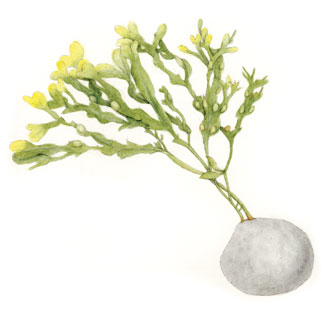 Saltwater report
Second in celebrity only to the rocks themselves on the rockbound coast of Maine is the rockweed, which blankets the rocks at low tide and rises above them at high tide like a floating forest. This yellow to dark-brown algae grows everywhere along the Atlantic intertidal zone, from the Carolinas to the Arctic and goes by too many different names to list here, but I’ll try anyway.
This weed is called knotted wrack, bladder wrack, bladder wort, black tang, rockweed, bladder fucus, sea oak, cut weed, Dyers fucus, red fucus, and rock wrack.
Botanical names include Fucus vesiculosus, Pelvetia festigiata, and Ascophyllum nodosum. It varies widely in form, size, and color, but can be recognized by its flat branches with attached bladders of air and its hold-fast to rocks that are exposed at low tide.
Rockweed is the great nursery of sea creatures small and large, providing shelter and nourishment to worms, snails, shellfish larvae, fish, sea ducks, and marine mammals. It is so abundant along the coast that it may be taken for granted, or even scorned for making the rocks slippery, or for tangling our oars, rudders, and propellers. Over the ages we have found many uses for it in foods, fertilizers, and cosmetics. The supply seems so abundant as to be almost endless.
Well, maybe not.
Rockweed has been harvested by the tons in Cobscook Bay for several years now, and the loss can be seen in many places. The result has been a great hue and cry, pro and con, and not a few sharp words exchanged. The harvesters calmly claim it is sustainable, while the conservationists sputter and turn various shades of red. What is more, there is little reason to think the practice will not move down the coast as each stretch of coastline is harvested out. A natural watchdog would be Maine’s Department of Marine Resources, but they are so overworked and understaffed already that they can barely monitor red tide, never mind the harvesting of rockweed along a gazillion miles of shoreline.
We’ve had a camp on Cobscook since 1976 and have seen some sad changes in the life of that beautiful bay. We used to routinely watch herring running close to shore, driven by squid feeding on them. In 1979 while we were out flounder fishing near Mahar’s old weir southwest of Kelly Point, we even met a female orca close enough to touch. Now we see few if any herring, no squid, no cetaceans, less kelp, more mud, and more green algae on the bottom. We’ve had fewer and fewer good days of clamming due to red tide and over-digging. The draggers have nearly dragged out the urchins, and they are getting ready to drag out the scallops, while plowing the bottom to kingdom come.
Rank opinion
Cobscook has been ravaged, in this commentator’s opinion. So the jolly attitude that cutting rockweed on the bay is sustainable rings a bit hollow, as does the cavalier claim that the rockweed industry can monitor itself.
Natural events, late October
The lowering angle of October light softens lines, muffles edges, and sometimes seems to originate inside the leaves of the flaming maples or within the pink clouds of dawn as though they were aglow with a lingering galvanic energy discharged by the autumn of the dying year. On cool, gray days, crows stalk around on the ground under the white ash trees feeding on their single-winged seeds, while on sunny afternoons, ladybugs, family Coccinellidae, gather on warm, sunlit walls in their black-and-orange Halloween costumes for a last jolly celebration, walking in circles, singing Finnegan’s Wake too softly for us to hear.
Tiny bits of white fluff float through the air—not plant, but animal—wooly apple aphids (Eriosoma lanigerum), a favorite prey of lady-bug larvae. The wooly aphids are sheepishly moving from their summer homes on the apple trees to their winter homes on the elms, where they will lay their eggs and die.
Maples, birches, and ashes are letting go their old leaves like a penitent giving up old habits, as dwindling light and frosty night turn our thoughts to our own mortality.
Is it any wonder that the days of the dead—Halloween, Samhain, All Saints, All Souls—are coming right over the horizon?
Mountain report, late October
The morning after the new moon last year I set out to climb our small, misty mountain. Tall fountains of fog rose up from the slopes to touch the clouds like the ghosts of the old-growth forests or the giants who felled them. But the summit was still visible and, much to my delight, marbled with white: the first snow of the season on Awanadjo.
While I trudged up the old state trail, melt water chattered down through the brooklets on either side and dripped from the trees. Farther up, the snow was decorated with bright, fallen leaves of birch and maple, and all gave off a bracing icy scent. The damp chill was something we hadn’t felt in months, and winter memories came rushing back like the faint strains of “Jingle Bells.” Chickadees bounced and squeaked happily from twig to branch, while wet red squirrels scolded the climbing pilgrim over their shoulders and the whole great mass of mountain let out a cold, foggy sigh. By the time I reached the bottom again, the snow was gone.
More seedpods to carry around with you
From John Donne: “No spring nor summer beauty hath such grace / As I have seen in one autumnal face.”
And from Emily Bronte: “Every leaf speaks bliss to me, fluttering from the autumn tree.”
That’s the almanack for this time. But don’t take it from us—we’re no experts. Go out and see for yourself.
Saltwater report
Second in celebrity only to the rocks themselves on the rockbound coast of Maine is the rockweed, which blankets the rocks at low tide and rises above them at high tide like a floating forest. This yellow to dark-brown algae grows everywhere along the Atlantic intertidal zone, from the Carolinas to the Arctic and goes by too many different names to list here, but I’ll try anyway.
This weed is called knotted wrack, bladder wrack, bladder wort, black tang, rockweed, bladder fucus, sea oak, cut weed, Dyers fucus, red fucus, and rock wrack.
Botanical names include Fucus vesiculosus, Pelvetia festigiata, and Ascophyllum nodosum. It varies widely in form, size, and color, but can be recognized by its flat branches with attached bladders of air and its hold-fast to rocks that are exposed at low tide.
Rockweed is the great nursery of sea creatures small and large, providing shelter and nourishment to worms, snails, shellfish larvae, fish, sea ducks, and marine mammals. It is so abundant along the coast that it may be taken for granted, or even scorned for making the rocks slippery, or for tangling our oars, rudders, and propellers. Over the ages we have found many uses for it in foods, fertilizers, and cosmetics. The supply seems so abundant as to be almost endless.
Well, maybe not.
Rockweed has been harvested by the tons in Cobscook Bay for several years now, and the loss can be seen in many places. The result has been a great hue and cry, pro and con, and not a few sharp words exchanged. The harvesters calmly claim it is sustainable, while the conservationists sputter and turn various shades of red. What is more, there is little reason to think the practice will not move down the coast as each stretch of coastline is harvested out. A natural watchdog would be Maine’s Department of Marine Resources, but they are so overworked and understaffed already that they can barely monitor red tide, never mind the harvesting of rockweed along a gazillion miles of shoreline.
We’ve had a camp on Cobscook since 1976 and have seen some sad changes in the life of that beautiful bay. We used to routinely watch herring running close to shore, driven by squid feeding on them. In 1979 while we were out flounder fishing near Mahar’s old weir southwest of Kelly Point, we even met a female orca close enough to touch. Now we see few if any herring, no squid, no cetaceans, less kelp, more mud, and more green algae on the bottom. We’ve had fewer and fewer good days of clamming due to red tide and over-digging. The draggers have nearly dragged out the urchins, and they are getting ready to drag out the scallops, while plowing the bottom to kingdom come.
Rank opinion
Cobscook has been ravaged, in this commentator’s opinion. So the jolly attitude that cutting rockweed on the bay is sustainable rings a bit hollow, as does the cavalier claim that the rockweed industry can monitor itself.
Natural events, late October
The lowering angle of October light softens lines, muffles edges, and sometimes seems to originate inside the leaves of the flaming maples or within the pink clouds of dawn as though they were aglow with a lingering galvanic energy discharged by the autumn of the dying year. On cool, gray days, crows stalk around on the ground under the white ash trees feeding on their single-winged seeds, while on sunny afternoons, ladybugs, family Coccinellidae, gather on warm, sunlit walls in their black-and-orange Halloween costumes for a last jolly celebration, walking in circles, singing Finnegan’s Wake too softly for us to hear.
Tiny bits of white fluff float through the air—not plant, but animal—wooly apple aphids (Eriosoma lanigerum), a favorite prey of lady-bug larvae. The wooly aphids are sheepishly moving from their summer homes on the apple trees to their winter homes on the elms, where they will lay their eggs and die.
Maples, birches, and ashes are letting go their old leaves like a penitent giving up old habits, as dwindling light and frosty night turn our thoughts to our own mortality.
Is it any wonder that the days of the dead—Halloween, Samhain, All Saints, All Souls—are coming right over the horizon?
Mountain report, late October
The morning after the new moon last year I set out to climb our small, misty mountain. Tall fountains of fog rose up from the slopes to touch the clouds like the ghosts of the old-growth forests or the giants who felled them. But the summit was still visible and, much to my delight, marbled with white: the first snow of the season on Awanadjo.
While I trudged up the old state trail, melt water chattered down through the brooklets on either side and dripped from the trees. Farther up, the snow was decorated with bright, fallen leaves of birch and maple, and all gave off a bracing icy scent. The damp chill was something we hadn’t felt in months, and winter memories came rushing back like the faint strains of “Jingle Bells.” Chickadees bounced and squeaked happily from twig to branch, while wet red squirrels scolded the climbing pilgrim over their shoulders and the whole great mass of mountain let out a cold, foggy sigh. By the time I reached the bottom again, the snow was gone.
More seedpods to carry around with you
From John Donne: “No spring nor summer beauty hath such grace / As I have seen in one autumnal face.”
And from Emily Bronte: “Every leaf speaks bliss to me, fluttering from the autumn tree.”
That’s the almanack for this time. But don’t take it from us—we’re no experts. Go out and see for yourself.

Rob McCall is a journalist, naturalist, fiddler, and for the past 22 years, has been pastor of the First Congregational Church of Blue Hill, Maine, UCC. Readers can contact him directly via e-mail: awanadjoalmanack@gmail.com.
 Illustration by Sam Manning.
Illustration by Sam Manning.Summer ends and autumn comes, and he who would have it otherwise would have high tide always and a full moon every night.
—Hal Borland
Dear Friends: Downeast Maine’s trademark fruit, the wild blueberry, is the great-grandmother of all lesser, cultivated varieties. I say lesser because, for all their bulk, no cultivated blueberry can match the superb flavor of the wild variety. I say great-grandmother because fruits are decidedly female. They are the ovaries that remain when the male parts of the flower have performed their duties, then dried up and fallen off. Blueberry culture may be the oldest form of agriculture in our region. We are told that slash-and-burn cultivation began during the middle archaic period in Maine, starting around 3,000 B.C. The first Maine natives noticed that blueberries came back more abundantly after a wildfire and began purposely burning the barrens. Burning the blueberry barrens is still a regular event in the spring, as are the occasional forest fires and house fires that accompany this ancient practice. The burning suppresses competitive vegetative growth and helps destroy damaging insects. More recent Maine history shows that blueberries were legally considered to be common property until about 1870. Like deer and other game, they could be taken by anyone, not just the owner of the land on which they grew. The invention of a canning process and action by the legislature changed all that, and led to a commercial blueberry industry and another kind of blueberry “baron.” The late Robert McCloskey’s classic book Blueberries for Sal spread the romance of this tiny fruit throughout the country during the 1950s. More recently, research showing that blueberries are a potent anti-oxidant has increased their popularity among the health-conscious. The harvest is in full swing by late August. The old wooden crates stenciled with the names of Wyman or Allen are now collector’s items, and the new multi-colored plastic flats are stacked in the fields and hauled to the coolers in flat-bed trucks. Meanwhile, rakers bend side-by-side to the harvest. Stores and road-side stands with their handmade signs overflow with bulging boxes of the beautiful fruit. Natural events Your commentator’s experience picking blueberries is mostly on the slopes of Awanadjo, Blue Hill, “small misty mountain” in Algonkian. One foggy morning several years ago our big black dog startled some rakers on those fields. “Did you think he was a bear?” I asked. “Oh yeah,” one of the rakers replied. “A big black bear came down off the mountain to eat berries just a little while ago and then ran back up over the mountain. We scared him, but no more than he scared us.” What could be more glorious than stooping under the wild blue yonder and plucking clumps of this delicious fruit until we can eat no more? Even the droppings of foxes, coons, and bears along the trails are blue. Maybe that is why the flag of the state of Maine is blue, too: Blueberries, blue tongues, blue fingers, blue barrens, blue herons, Blue Hill, blue water, blue yonder, blue planet... and blue hearts when this true-blue season ends.
 Illustrations by Candice Hutchinson [3].
Illustrations by Candice Hutchinson [3].

Yr. mst. hmble & obd’nt servant,
Rob McCall

Rob McCall is a journalist, naturalist, fiddler, and for the past 22 years, has been pastor of the First Congregational Church of Blue Hill, Maine, UCC. Readers can contact him directly via e-mail: awanadjoalmanack@gmail.com.
Related Articles
Share this article:
2023 Maine Boat & Home Show

Join Us for the Maine Boat & Home Show!
Art, Artisans, Food, Fun & Boats, Boats, Boats
August 11 - 13, 2023 | On the waterfront, Rockland, Maine
Click here to pre-order your tickets.
Show is produced by Maine Boats, Homes & Harbors magazine.








